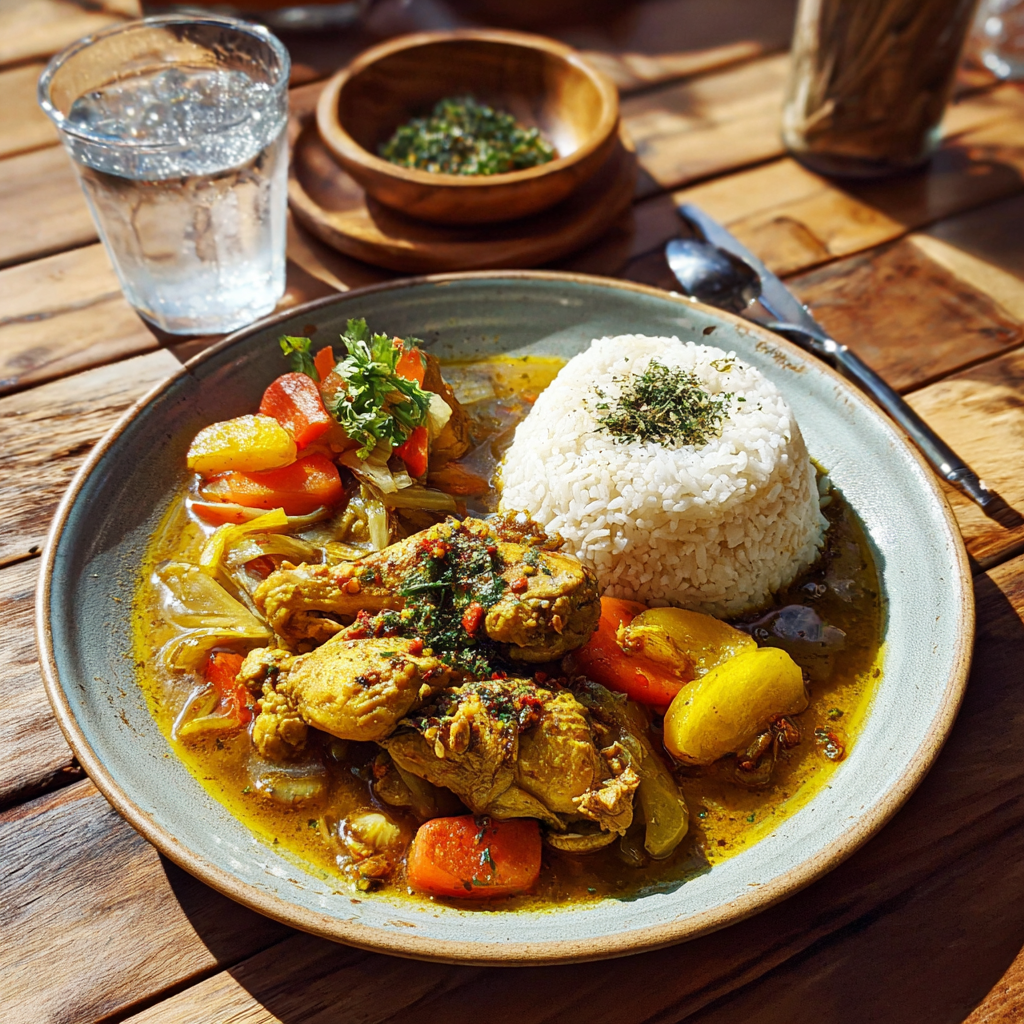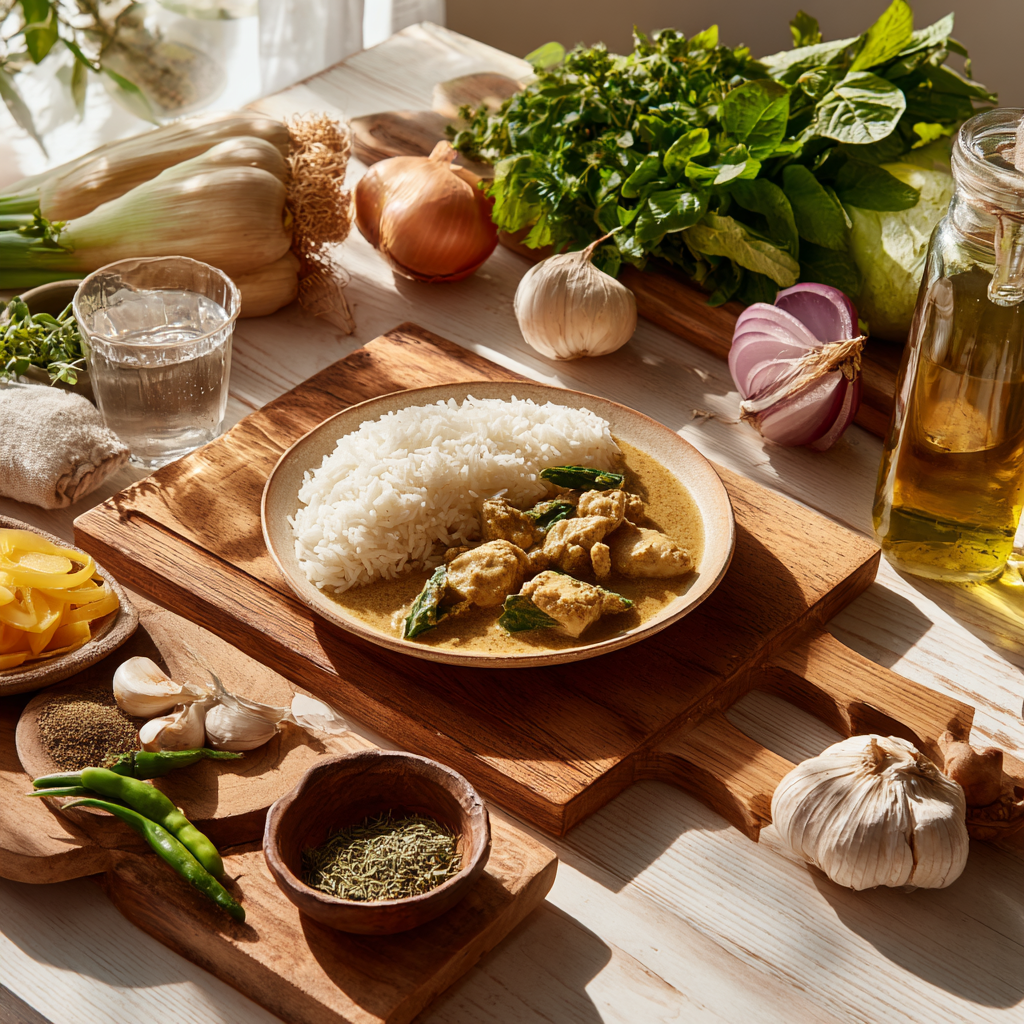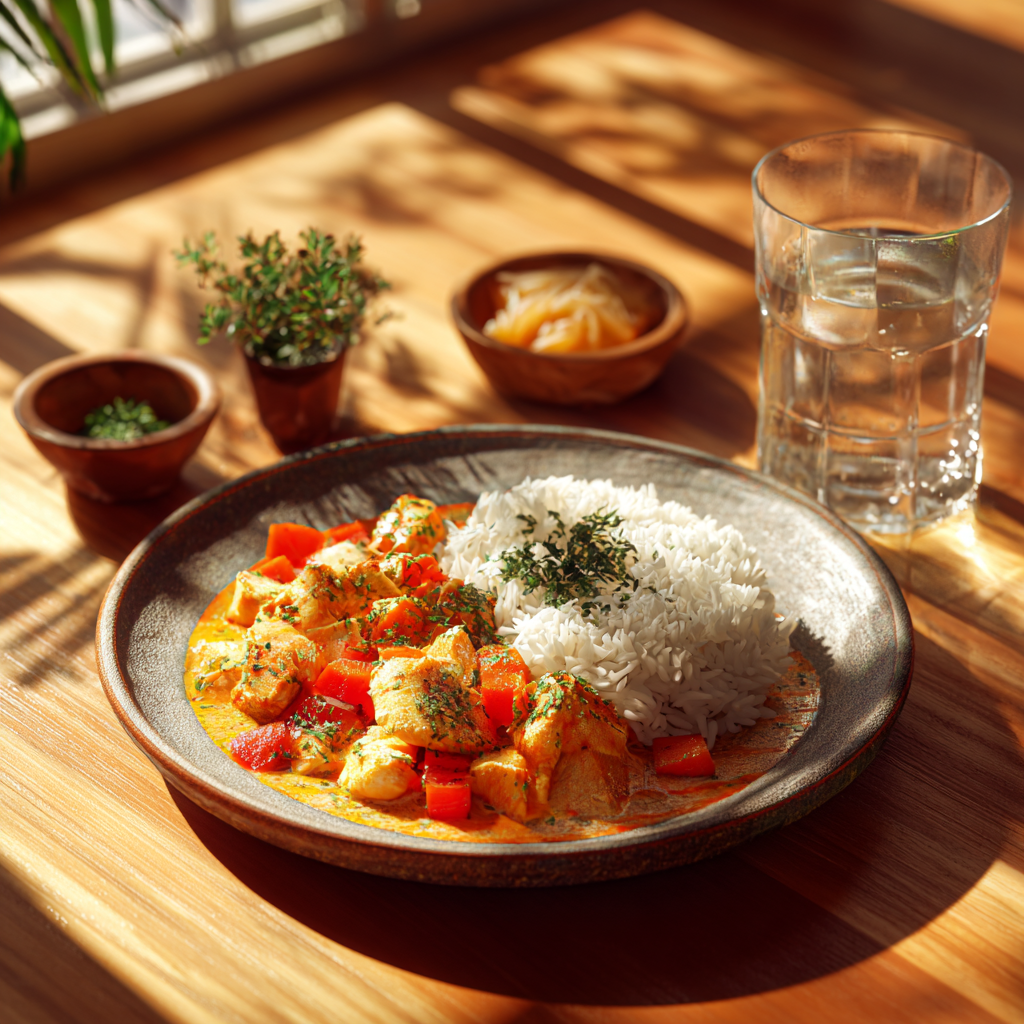Introduction
I still remember the first time I smelled my mom’s chicken curry simmering on the stove. The aroma of garlic, ginger, and coconut milk filled the entire house. It was warm, inviting, and unforgettable. That’s when my love for cooking Filipino dishes began. Filipino chicken curry is one of those meals that feels like home. It’s comforting, flavorful, and has a unique blend of local and international influences.
This article will guide you step-by-step in making an authentic recipe Filipino chicken curry. Along the way, I’ll answer common questions like: What are the ingredients of Filipino chicken curry? What makes Filipino curry different? Let’s get started.
What Makes Filipino Chicken Curry Unique?
Filipino chicken curry stands out because it’s milder compared to other curries. If you’ve tried Indian or Thai curries, you’ll notice that Filipino versions are less spicy but just as rich in flavor. This difference comes from the balance of spices and the generous use of coconut milk. For me, it’s all about comfort without overwhelming heat.
The ingredients of Filipino chicken curry are simple yet essential. You’ll need:
- Turmeric – gives the dish its vibrant yellow color
- Garlic – adds depth and aroma
- Ginger – brings warmth and freshness
- Onions – build the base flavor
- Coconut milk – creates a creamy, rich texture
These ingredients work together to create a dish that’s both familiar and exciting. The turmeric and ginger bring international flair, while the coconut milk ties it back to Filipino cooking traditions.
So, what makes Filipino curry different? It’s not just about the spices. Filipino curry often includes potatoes and carrots, which add sweetness and heartiness. These veggies soak up the sauce, making every bite satisfying. Plus, the dish uses fewer spices than Indian curries, focusing instead on simplicity and balance. For example, you won’t find complex spice blends here—just a handful of key players doing their job well.
A common mistake people make is rushing the cooking process. Curry needs time to develop its flavors. Don’t skip steps like sautéing the garlic, ginger, and onions. This trio forms the foundation of the dish. Another tip: don’t skimp on the coconut milk. Use full-fat for the creamiest result. Trust me, it makes a difference.
Now, let’s talk about the secret to a good curry. It’s all about layering flavors. Start by browning your chicken to lock in juices. Then, slowly cook the spices with the aromatics. Add the coconut milk last, letting it simmer gently so the flavors meld. Patience is key. I’ve learned this the hard way after a few underwhelming attempts!
Filipino chicken curry isn’t just food—it’s a story. It reflects how Filipino cuisine embraces global influences while staying true to its roots. Whether you’re new to cooking or a seasoned home chef, this dish is worth trying. With the right ingredients and a little care, you can bring this comforting meal to your table.
Step-by-Step Recipe for Filipino Chicken Curry
Alright, now that you’ve got a sense of what makes Filipino chicken curry special, let’s roll up our sleeves and get cooking. This dish is perfect for beginners and pros alike—it’s forgiving but still delivers incredible flavor. Plus, it’s a great excuse to stock your pantry with essentials like turmeric and coconut milk. Funny enough, I once forgot to buy curry powder and tried substituting garam masala. Let’s just say it didn’t turn out quite right. Lesson learned: stick to the basics.
Ingredients You’ll Need
Before we dive into the process, let’s make sure you have everything on hand. The beauty of recipe Filipino chicken curry with coconut milk lies in its simplicity. You’ll need fresh produce and a few staple spices. Here’s a quick rundown:
- 1.5 lbs of chicken thighs (bone-in works best for extra flavor)
- 2 medium onions, finely chopped
- 4 cloves of garlic, minced
- A thumb-sized piece of ginger, grated
- 2 medium potatoes, peeled and cubed
- 1 medium carrot, sliced into rounds
- 3 tablespoons of curry powder (store-bought or homemade)
- 1 teaspoon of ground turmeric
- 1 can (about 14 oz) of coconut milk—full-fat, please!
- 2 cups of water or chicken broth (I prefer broth for added depth)
- Salt and pepper to taste
- 2 tablespoons of cooking oil (vegetable or coconut oil both work)
By the way, if you’re wondering where to find these ingredients, most grocery stores carry them. For a more authentic touch, check out Asian markets. They often have fresher spices and richer coconut milk. And hey, while you’re at it, why not grab some extra ingredients to try out another comforting dish like this recipe for demos chicken and rice soup? It’s a great complement to your curry repertoire.
Cooking Instructions
Now comes the fun part. Cooking Filipino chicken curry is all about layering flavors step by step. Don’t rush it—it’s worth taking your time. Here’s how to do it:
- Sautéing the Aromatics: Heat your oil in a large pot over medium heat. Toss in the onions first, letting them soften and turn translucent. Add the garlic and ginger next, stirring constantly so they don’t burn. This trio is the soul of the dish, so give it a good 3-4 minutes to develop that fragrant base.
- Browning the Chicken: Once your aromatics are ready, add the chicken pieces to the pot. Let them sear for a few minutes on each side until they’re golden brown. This step locks in the juices and gives the curry a deeper flavor. Pro tip: don’t overcrowd the pot. Cook in batches if needed.
- Incorporating Spices: Sprinkle in the curry powder and turmeric, stirring well to coat the chicken evenly. Toasting the spices for a minute or two releases their oils and enhances their aroma. Trust me, this small step makes a huge difference.
- Simmering in Coconut Milk: Pour in the water or broth, scraping up any brown bits from the bottom of the pot. These bits are packed with flavor, so don’t skip this part. Add the potatoes and carrots, then cover and let everything simmer for about 15 minutes. Finally, stir in the coconut milk and let it gently bubble for another 10-15 minutes until the veggies are tender and the sauce has thickened slightly.
Here’s the thing: patience really is key here. One common mistake people make is cranking up the heat to speed things along. Resist the urge! A low and slow simmer ensures the flavors meld beautifully. Another pitfall? Skipping the browning step. Sure, it adds an extra 5 minutes, but it’s worth every second. If you’re looking for more ways to elevate your chicken dishes, this chicken and wild rice soup publix recipe might inspire you.
The Secret to a Perfect Curry
So, what’s the secret to a good curry? Balance. You want the spices to shine without overpowering the dish. The creaminess of the coconut milk should complement the savory notes of the chicken, while the sweetness of the potatoes and carrots ties everything together. It’s like a symphony of flavors, and every element needs to play its part.
To nail this balance, start with high-quality ingredients. Fresh ginger and turmeric make a world of difference compared to their dried counterparts. And when it comes to curry powder, don’t skimp. Invest in a good brand or, better yet, make your own blend. My go-to mix includes cumin, coriander, turmeric, and a pinch of cinnamon. Speaking of blends, if you’re curious about other curry variations, check out this chicken curry recipe pinoy for inspiration.
Another tip: don’t overcook the chicken. Bone-in thighs are forgiving, but even they can dry out if left simmering too long. Aim for juicy, tender bites every time. Oh, and one last thing—taste as you go. Adjust the seasoning gradually, adding salt, pepper, or even a squeeze of lime juice at the end for brightness.
Random thought: ever notice how curries seem to taste even better the next day? That’s because the flavors continue to develop as they sit. If you’re meal prepping, this dish is a winner. Just reheat gently on the stove or in the microwave, adding a splash of water or broth if the sauce thickens too much.
By the way, if you’re craving something hearty yet different, this cracker barrel chicken and rice recipe is a fantastic option. It’s cozy, creamy, and pairs wonderfully with leftover curry for a mashup of comfort foods.
At the end of the day, Filipino chicken curry is more than just a recipe—it’s a reminder of home, family, and shared meals. Whether you’re whipping it up for yourself or feeding a crowd, this dish will leave everyone smiling. So grab those ingredients, take your time, and enjoy the process. Happy cooking!
Serving Suggestions and Pairings for Recipe Filipino Chicken Curry
Alright, the curry’s ready. Now comes the fun part—how to serve it up in a way that makes it shine. I’ll never forget the first time I served my chicken curry with plain white rice. It was good, sure, but when I paired it with garlic fried rice the next time? Game changer. The slight crunch of the rice against the creamy curry sauce was pure magic.
If you’re looking for classic options, steamed jasmine rice is always a winner. It’s light, fluffy, and lets the curry take center stage. For something with more texture, try coconut rice. Cooking your rice with a splash of coconut milk adds a subtle sweetness that complements the dish beautifully. By the way, if you’re hosting a dinner party, serving the curry in a hollowed-out bread bowl (like a small sourdough or even pandesal) can be a showstopper. People love a little wow factor!
Pickled vegetables are another fantastic pairing. Their tangy bite cuts through the richness of the curry, balancing everything out. I like making quick pickled cucumbers or carrots with vinegar, sugar, and a pinch of salt—it’s super easy and adds a refreshing contrast. And here’s a random thought: crispy pappadums or even plain crackers work surprisingly well too. The crunch factor is oddly satisfying.
Customizing Your Curry
One thing I adore about recipe Filipino chicken curry is how adaptable it is. Not a fan of potatoes? Swap them out for sweet potatoes instead—they add a natural sweetness that pairs wonderfully with the spices. Or, if you’re feeling adventurous, toss in some chickpeas for extra protein. Trust me, they soak up the sauce like sponges and make the dish heartier.
Spice lovers, this one’s for you. If you want to kick things up a notch, add a fresh chili or two while cooking. Bird’s eye chilies are great for heat, or you could stir in some sriracha at the end for a milder kick. On the flip side, if you’re cooking for kids or someone who’s spice-averse, dial it back by using less curry powder or skipping the turmeric entirely. Flexibility is key here.
Another trick I’ve learned over the years is to finish the dish with fresh herbs. A handful of cilantro or Thai basil sprinkled on top just before serving adds brightness and elevates the whole meal. Oh, and don’t underestimate the power of citrus! A squeeze of calamansi or lime juice right before plating can brighten the flavors in ways you wouldn’t believe.
Funny enough, I once tried adding pineapple chunks to my curry, thinking it might mimic the tropical vibe of coconut milk. Turns out, it worked! The sweetness balanced the savory notes perfectly. Just goes to show, experimenting pays off sometimes.
Why This Recipe Filipino Chicken Curry Stands Out
So, why does this particular curry stand out among others? For starters, it’s approachable. Unlike some curries that require hours of prep or hard-to-find ingredients, this version keeps things simple without sacrificing flavor. The balance of mild spices, creamy coconut milk, and hearty veggies makes it universally appealing. Plus, its versatility means you can tweak it to suit your mood or pantry contents.
Here’s the thing: Filipino cuisine has a way of blending global influences with local traditions, and this curry is a prime example. It borrows elements from Indian and Southeast Asian cuisines but stays true to Filipino comfort food roots. That’s what makes it so special—it’s familiar yet exciting, comforting yet bold.
If you’re interested in exploring more recipes that celebrate this kind of fusion cooking, check out our main category page. You’ll find plenty of dishes that highlight the same vibrant mix of flavors and techniques.
Wrapping It Up
Cooking is as much about the experience as it is about the food itself. There’s something deeply satisfying about creating a dish like recipe Filipino chicken curry from scratch. Whether you’re sharing it with family, friends, or simply enjoying it solo, every bite tells a story. So go ahead, give this recipe a shot—and feel free to put your own spin on it. After all, the best meals are the ones made with love and a dash of creativity.
Before you dive in, remember: cooking should be fun. Don’t stress about perfection. Even if something doesn’t turn out exactly as planned, there’s always next time. And honestly, those little imperfections often lead to the most memorable meals. Enjoy the process, savor every bite, and let the aromas transport you straight to your happy place.
FAQ Section
- What are the ingredients of Filipino chicken curry?
At its core, Filipino chicken curry includes chicken thighs, onions, garlic, ginger, turmeric, curry powder, coconut milk, potatoes, and carrots. These ingredients come together to create a rich, flavorful dish that’s both comforting and satisfying. - What makes Filipino curry different?
Filipino curry stands out because it’s milder and creamier than other varieties. Instead of heavy spicing, it relies on coconut milk for richness and uses fewer spices overall. The addition of potatoes and carrots also gives it a unique, hearty twist. - What are some common mistakes to avoid when making chicken curry?
Rushing the cooking process is a big no-no. Take time to sauté the aromatics properly and let the curry simmer slowly. Also, avoid skimping on coconut milk—always opt for full-fat for the best texture. Lastly, taste as you go to ensure proper seasoning. - What is the secret to a good curry?
Layering flavors is essential. Start by building a strong base with aromatics, then toast your spices to release their oils. Use high-quality ingredients, especially fresh ginger and turmeric, and don’t rush the simmering stage. Patience truly pays off. - Can I make this curry vegetarian?
Absolutely! Replace the chicken with tofu, chickpeas, or mixed vegetables. The rest of the recipe remains the same, and the result will still be deliciously creamy and flavorful. - How long does Filipino chicken curry last in the fridge?
Stored in an airtight container, it should last up to 4 days. Reheat gently on the stove, adding a splash of water or broth if needed. Many people claim it tastes even better the next day! - Is Filipino chicken curry spicy?
Typically, no. It’s known for being mild and family-friendly. However, you can easily adjust the spice level by adding fresh chilies or hot sauce according to your preference. - What type of rice pairs best with this curry?
Jasmine rice is a classic choice, but coconut rice or garlic fried rice also pair beautifully. Experiment to see which option you like best—it’s all about personal preference. - Can I freeze Filipino chicken curry?
Yes, it freezes well for up to 3 months. Let it cool completely before transferring to freezer-safe containers. Thaw overnight in the fridge and reheat on the stove for best results. - Why is my curry too thin or too thick?
If it’s too thin, let it simmer uncovered for a bit longer to reduce the liquid. If it’s too thick, add a little water or broth until you reach your desired consistency. Remember, curry sauces thicken as they cool.

Recipe Filipino Chicken Curry
Ingredients
Equipment
Method
- Heat oil in a large pot over medium heat and sauté onions until translucent.
- Add garlic and ginger, stirring constantly for 3-4 minutes.
- Add chicken pieces and sear until golden brown on all sides.
- Sprinkle curry powder and turmeric over chicken and stir to coat evenly.
- Pour in water or broth, scraping up any brown bits from the pot.
- Add cubed potatoes and sliced carrot, cover, and simmer for 15 minutes.
- Stir in coconut milk and let simmer for another 10-15 minutes until veggies are tender.


